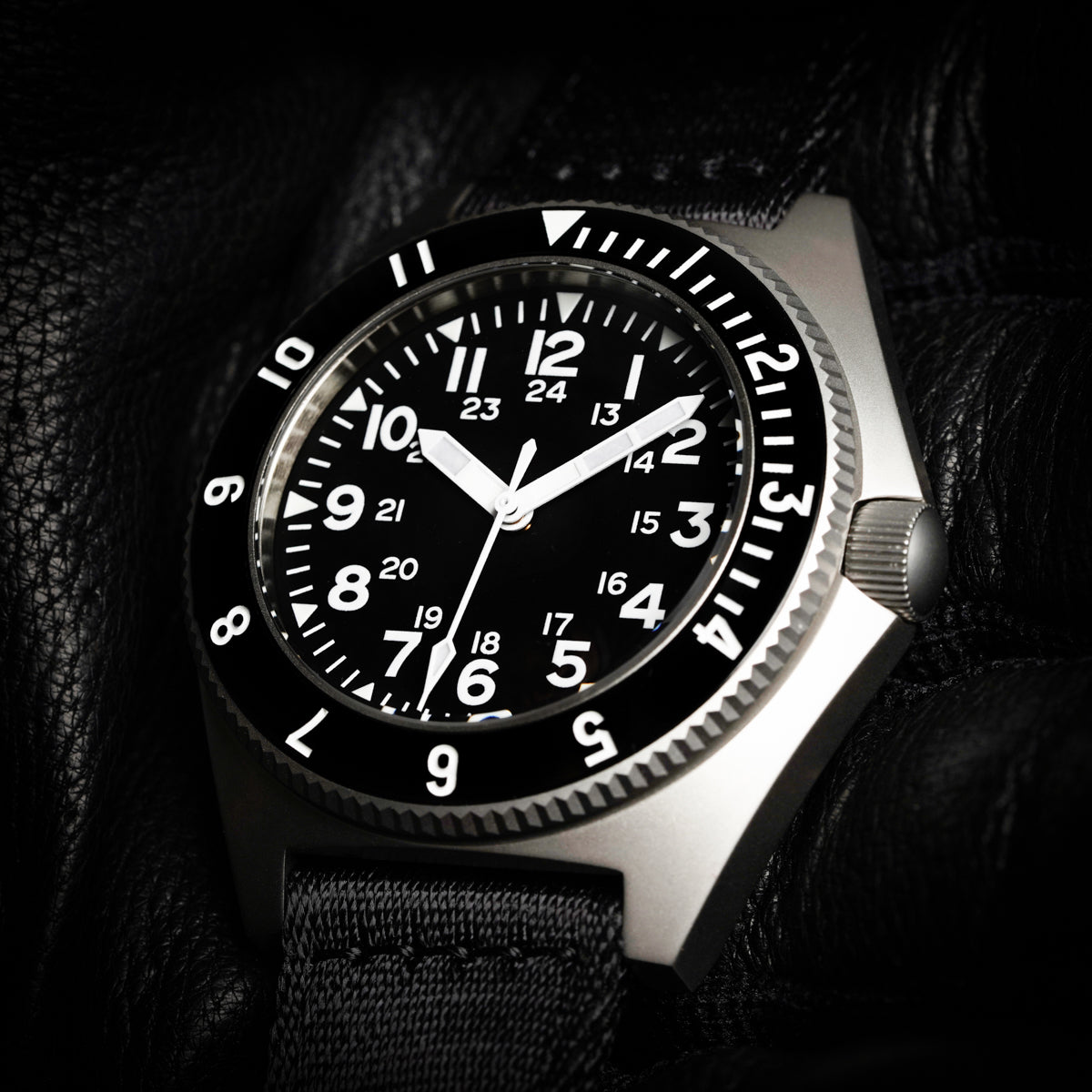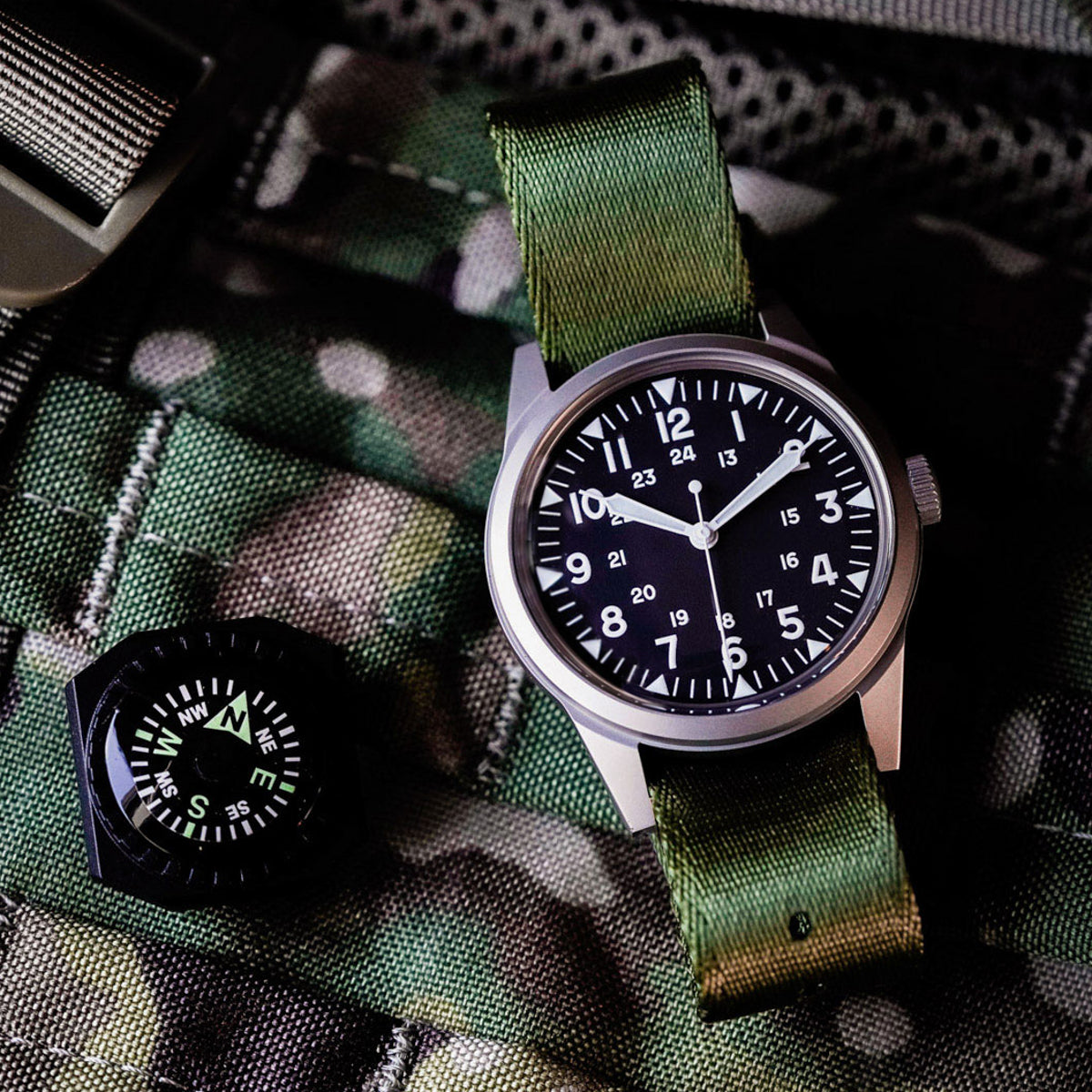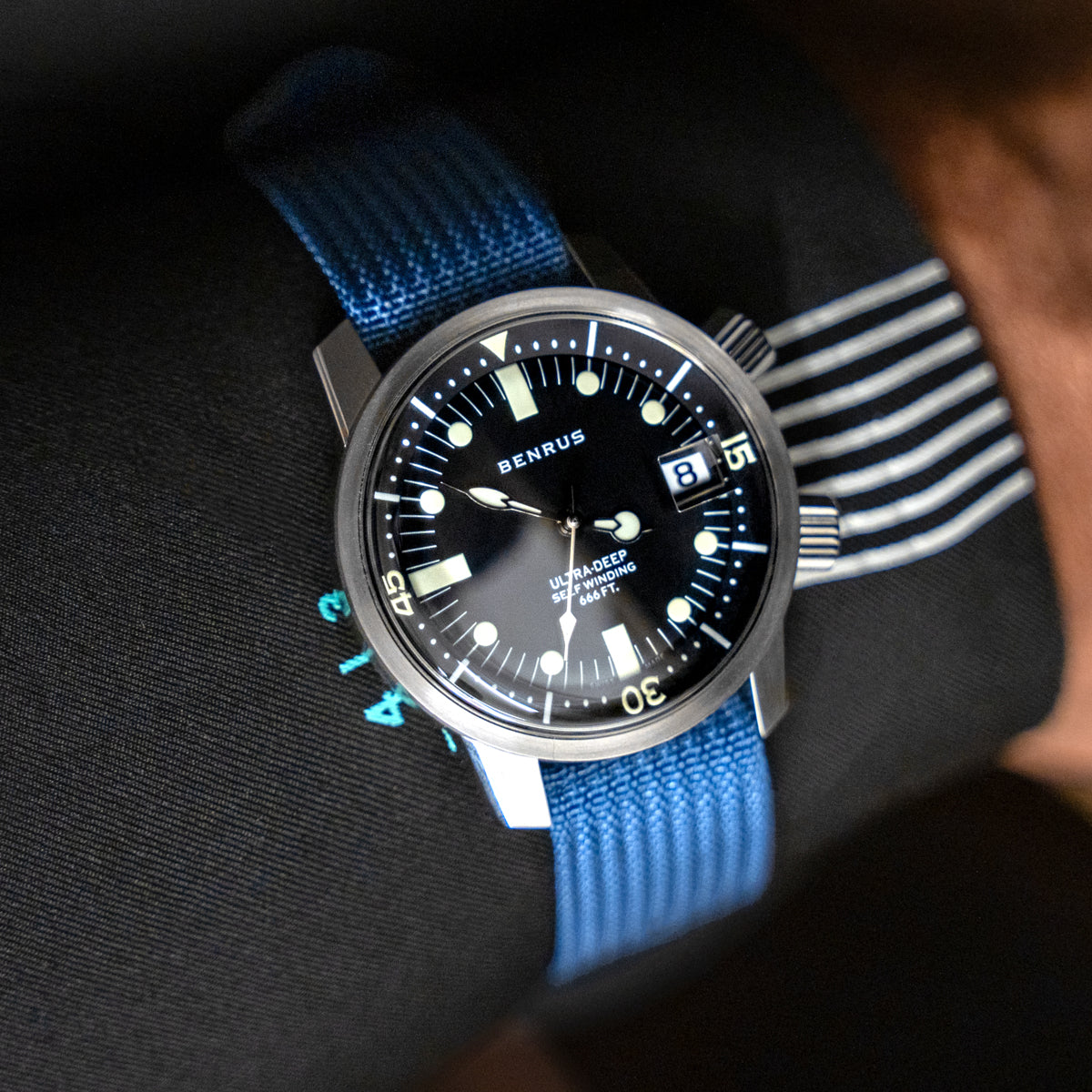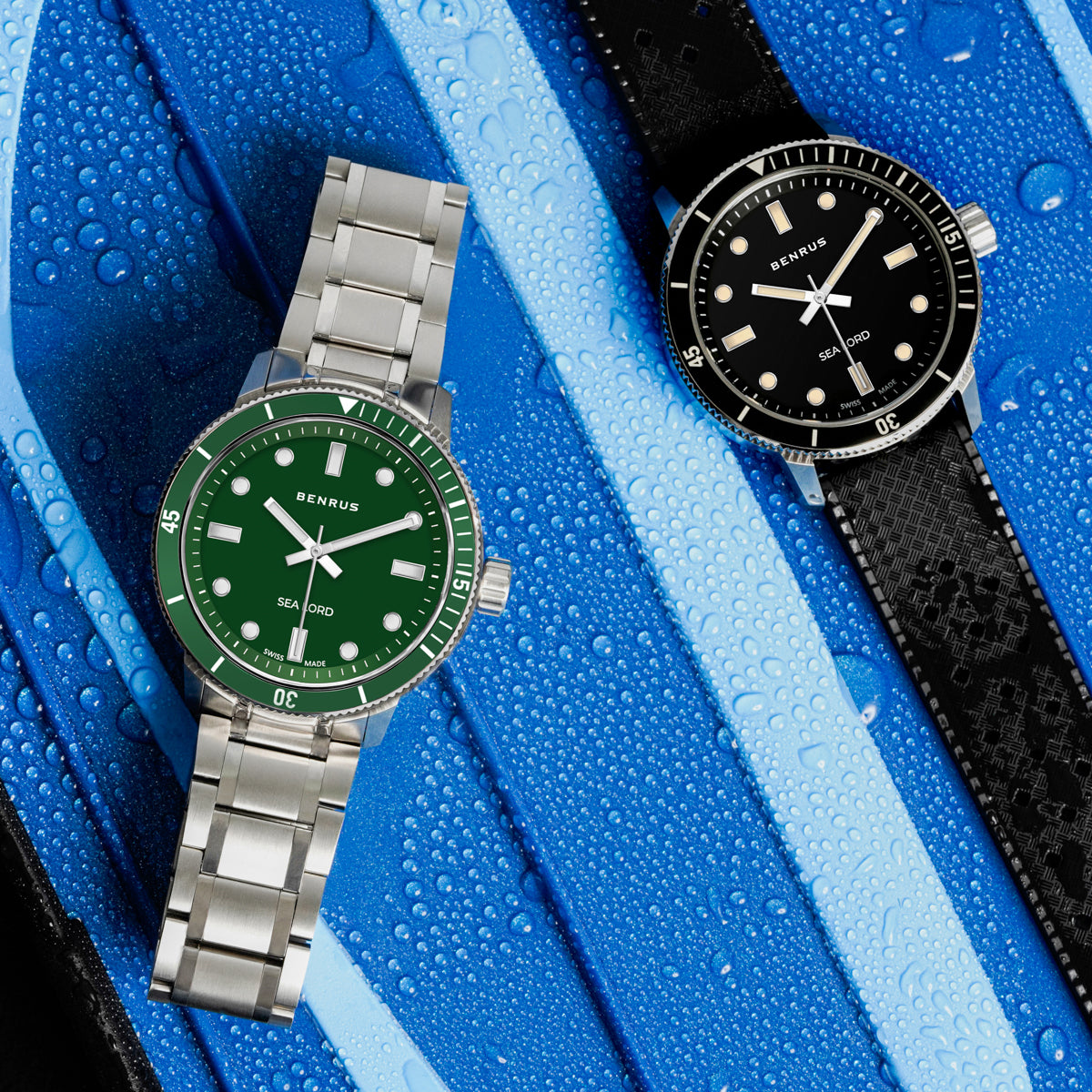
TYPE I STORIES
Veteran, David Bailey
Ireceived the Type I when I was an EOD DET Norfolk in the late 1990s. The supply guy on our team went to DRMO where surplus gear is turned in and came back with six Type I’s, new in the boxes. One was issued to each member of the team.
I personally wore the Type I daily and it accompanied me on my many adventures being an EOD Technician. From parachuting, diving, and blowing things up to serving on Secret Service Presidential details at Kennebunkport, Maine and other places.
We wore them all the time and were always complimented on them. The simplicity of the watch and its easy to read face were a plus, so it wasn’t a surprise that it completed many dives with me. As a diver, our lives depended on quality timepieces to monitor our dive times and the Type I was just that. It wasn't until later that I learned of the rich history of the Type I from a watch repair guy when I had the scratched crystal replaced. I was surprised and honored to be in possession of one.
23 years U.S. Navy
16 years Explosive Ordnance Disposal Technician
20 years U.S. Navy
Veteran, David Windsor
Oh what an adventure I’ve had. I enlisted in the Navy on my 17th birthday and since then have served on seven ships and seven shore stations. I attended boot camp in San Diego, went to New London for sub school and then got orders to the USS Wasp CVS-18 out of Boston. I did a lot of traveling from the Caribbean to the Congo during the Mao Mao uprising, where I was a machine gunner on the ship's landing party and helped to evacuate people. I was also on the largest ship to go up the St Lawrence River when it was enlarged and was part of the rescue and recovery of the collapsed Texas Tower off Long Island. From Damage Control schooling, Fire Instructor School and several other missions from Guam, California, and Virginia, I finally went on to 2nd class Dive School while stationed aboard the USS Cascade. While the ship was in Naples, Italy in 1971, I was transferred to First Class Dive School at the Washington DC Navy Yard. From there I was assigned to the USS Tringa in Key West, FL where I was part of the rescue mission for the mini-sub, Sea Link.
In 1973 the ship was re-home ported to New London, CN and in 1974 I received orders to Keyport, WA where I "met" my BENRUS Type I dive watch. I wore it on many of my recovery missions of test run torpedoes, in which I needed a non-magnetized watch. Somewhere along the way in my early-undocumented adventures while stationed there, I lost the stem and the watch drowned.
Veteran, Jake Brodersen
Iwas issued my Type I as a student navigator in the Air Force at Mather Air Force Base CA in 1979. It happened during my first week in the Air Force. I stood in the supply line and was issued all of the tools that I would need to start a career as a navigator. The Type I watch was among those items. Even though I was just a student at the time, I felt like a real professional when wearing it.
As I learned navigation, timing was always critical. We started engines on time. We took off on time. And hopefully, landed on time. The watch was central to my every move during flight. Each flight always began with a mission planning session early in the morning. The very first thing we did was to synchronize our watches with the WWV time source that was broadcast over the high frequency (HF) radio. Every student in the room stopped their work to get their watch synchronized. We relied on our watch to maintain timing throughout the day (or night) flight.
As our training in navigation progressed, we learned celestial navigation. We took measurements through a sextant of the sun, the stars, and the moon. Each observation needed to be meticulously timed. An error in timing could put our plane miles off course. This would not make the air traffic controllers happy, nor would it enable a passing grade in our classes. We relied on our watch to keep us out of trouble and on course.
20 years U.S. Air Force

I graduated navigator training and completed a 20-year career in the Air Force flying aboard a wide variety of fighter and bomber aircraft, but mainly the B-52 Stratofortress. As a Master Navigator, the Type I was on my wrist the entire time. Digital watches came along, but were often fussy about settings and buttons. You needed to carry the manual with you if you needed to reset the time or date. My Type I was always ready and easy to read, even on the night missions I would fly during Desert Storm.
I ended up flying ten very long missions into Iraq during Desert Storm, dropping bombs with the precision that I had been trained to do, all timed with my trusty Type I. Each mission was 16-17 hours long, which didn’t include showing up four hours early for each flight or the two-hour long debriefings at the end of the day. Timing ruled my daily routine.
I valued my service in the Air Force. I have continued to support the Air Force after my retirement as a DoD contractor. I work alongside active duty pilots and navigators daily. They are often surprised that I wear a watch with no “features,” but I prefer the classic style and simplicity of the Type I. Do I own other watches? Sure. I have a variety that includes a specialized sailing watch and an iWatch. They are all tools, but lack the character of a classic watch.


U.S. Navy Seal
Veteran, Keith Screen
In the early Spring of 1975 there were a number of classified missions preceding Operation Frequent Wind which immediately preceded the fall of Saigon. These classified missions included Seal and Marine Recon units in H-46’s that came in under cover of darkness to extract other special ops teams which had been in place as well as high brass just outside of Saigon.
Seal Keith Screen was on an H-46 with his Team on a mission to extract a Marine Recon unit during this period of early extractions and just as they were lifting off the H-46 was grazed by a rocket, which exploded and threw most of both teams out of the H-46 to the ground. Those Teams held off fire and multiple attacks while waiting on another extraction.
It was this event that resulted in the damage to the crown and crystal of Keith's Type 1. Keith and a number of other Team members were injured and a few Team members were lost.
Keith kept the watch in the condition it was in as a reminder of his lost brothers. His widow was kind enough to share this story with its new owner who mentioned that he would think about whether to fix the crown or leave as is. She told him that he was crazy to leave it as is and that Keith would agree. She went on to say that Keith would want it to be enjoyed and appreciated by someone who knew its story.
As told to Eric Wind, Founder/CEO of Wind Vintage







